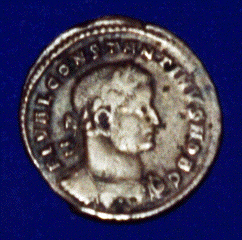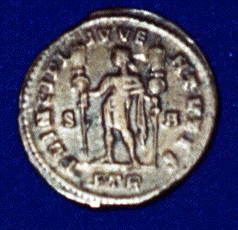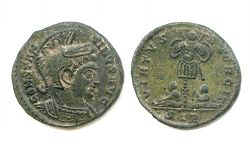|
Romans in Germany
A Workshop/Seminar held at Temple
University, Ambler Campus
March 24, 2001
A Webliography
for Romans in Germany
compiled by Dr. Janice Siegel
RECONSTRUCTING
THE PAST
-
The
Society for experimental archeology and historical presentations
VEX LEG VIII AUGUSTA: The Vexillatio LEGIO VIII AUGUSTA
is a group of people who are interested in Roman History,
especially concerning the 1st century A.D. Since 1991 we
reconstruct all kind of ancient weapons, tools and daily-life
stuff. During our events, several
Roman soldiers show different types of armour, reconstructed
catapults (scorpio), a
Roman camp and civilian
items are on display like a provincial clothes fashion-show,
a
religious ceremony, a Roman woman doctor (medica) with her
typical equipment and a Roman writer`s office (scriptor). Our
main-point is to show a group of the Legio with special tasks (vexillatio),
that was sent from the Legion`s headquarters in Strasbourg/
Argentorate (France) to nowadays South-West Germany (Baden-
Wuerttemberg), to fulfill extra orders like land-surveying,
customs control, police tasks or as a construction unit etc. Therefore
we reconstructed the tools that belong to these items ( e.g. a
crane). We are involved in Roman festivals and Museum Events
mainly in SW-Germany, but also abroad ( Holland, Austria), and
give "living-history-lessons" at schools.
-
Kalkriese
99
-
Reenactment
of Battle! During the period October 3d to 8th, 2000,
The Roman Legion XXII conducted a reenactment in Springfield,
Missouri of activities common by Roman Soldiers during the
period A.D. 39 to A.D. 197 in what is now Germany. http://63.92.62.83/RLegionReenact.htm
travelogues
by regular people, some decent photos, some handy practical info
Specifically for kids
Augusta
Treverorum
Treveris
Trier
PHOTO ALBUM
Porta
Nigra (the largest surviving Roman gate north of the Alps)
Reproductions
of Roman busts from Trier (displayed in the foyer of the Academy
of European Law in Trier because they reflect the diversity of the
region’s population then as well as now)
Rheinisches
Landesmuseum Trier
German
only
http://www.uni-trier.de/trier/lm/rlmt.htm
Irene
B. Hahn’s Tour of Trier
Carlo
Del Vecchio’s Tour of Trier (in English and German)
EXCELLENT!
Universitat
Trier’s site dedicated to Roman Trier (includes hyperlinks to
short blurbs on all Roman monuments and ruins)
One page write-ups on Trier
(all with a nod to the Roman aspects):
Articles about
Roman finds in Trier (web-accessible)
St. Alexander – martyr
during reign of Diocletian (3rd century)
http://saints.catholic.org/saints/alexanderd3rd.html
More martyrs of Trier: http://saints.catholic.org/saints/martyrsoftrier.html
From http://www.roman-emperors.org/conniei.htm:
The Emperor Constantine
Constantine,
in the meanwhile, had served with distinction under both Diocletian
and Galerius
in the East. Kept initially at the court of Galerius
as a pledge of good conduct on his father's part, he was later
allowed to join his father in Britain and assisted him in a campaign
against the Picts. When Constantius
died, on 25 July 306, at Eburacum (York), Constantine was at his
side. The soldiers at once proclaimed him Augustus; [[6]]
Constantine henceforth observed this day as his dies imperii. Having
settled affairs in Britain swiftly, he returned to the Continent,
where the city of Augusta Treverorum (Trier) served as his principal
residence for the next six years. There, too, in 307, he married Maximian's
daughter
Fausta, [[7]]
putting away his mistress Minervina, who had borne him his first
son, Crispus.
[[8]] Trier's
"Kaiserthermen" (Imperial Baths) and Basilica (the aula
palatina ) give evidence to this day of Constantine's residence
in the city.
At
the same time the Senate and the Praetorian Guard in Rome had allied
themselves with
Maxentius, the son of Maximian.
On 28 October 306 they proclaimed him emperor, [[9]]
in the lower rank of princeps initially, although he later
claimed the rank of Augustus. Constantine and Maxentius,
although they were brothers-in-law, did not trust each other. Their
relationship was further complicated by the schemes and
consequently, in 310, the death of Maximian.
Open hostilities between the two rivals broke out in 312, and
Constantine won a decisive victory in the famous Battle
of the Milvian Bridge. [[10]]
This made Constantine the sole ruler of the western half of the
empire.
…
In
335 Athanasius, now bishop of Alexandria and unbending in his
opposition to some of Constantine's policies, was sent into exile at
far-away Trier. [[25]]
The
New Rome
During
the First Tetrarchy Trier, Milan, Thessalonike, and Nicomedia had
served as imperial residences, and the importance of Rome as a
center of government had thus been considerably reduced. Constantine
went far beyond this when he refounded the ancient Greek city of
Byzantium as Constantinople and made it the capital of the empire.
His decision to establish a new capital in the East ranks in its
far-reaching consequences with his decision to adopt Christianity.
The new capital enjoyed a most favorable location which afforded
easy access to both the Balkan provinces and the eastern frontier,
controlled traffic through the Bosporus, and met all conditions for
favorable economic development.
Mosaics:
http://ccat.sas.upenn.edu/jod/apuleius/trier.html
From
Vroma: mosaic found in the imperial baths serves as chariot racing
lesson
http://www.vroma.org/~bmcmanus/circus.html
some nice pictures of
architectural detail in touristy photos of Trier: http://members3.clubphoto.com/shelley228252/Trier_Germany_Trier_and_our_hotel/icons.phtml
German tourist site of baths:
http://www.caltim.com/rheinland/imperial_baths.htm
good site in German: http://www.markaurel.de/augustatrever.htm
nice photo of baths
http://www.cs.washington.edu/homes/zives/personal/trier.htm
announcement of finds of Roman
ruins in Trier, Science News, 1929: http://www.sciencenews.org/sn_arc99/6_19_99/timeline.htm
Search for pictures of Roman
ruins in German here:
http://www.planetware.com/photos/PHD.HTM
Present-day names of Roman
cities (for ref): http://www.geocities.com/~stilicho/cities.html
Picture/info on coin struck in
Trier: http://myron.sjsu.edu/caesars/LOWCOST.HTM
Search for Trier on this site
for four pictures: http://cricket.csuchico.edu/art/delta/roman.html
Pictures of Roman ruins in
Trier: http://www.washington.edu/ark2/archtm/Germany.html
Subject: basilica
(Constantine's palace) exterior
, exterior
, interior
, detail,
, rick work , detail,
brick work , Roman
city gate
Little internet encyclopedi
article on Romn Rule: http://www.infoplease.com/ce6/history/A0858344.html
More
on coins minted in Trier:
The Roman Imperial Sestertius by R.Hudson http://www.abijess.freeserve.co.uk/The%20Roman%20Imperial%20Sestertius.htm
A woman’s toilette (photo) from the Trier
Landesmuseum:
http://www.vroma.org/images/mcmanus_images/toilette2.jpg
buy a cross-stitch of the
Porta Nigra!
http://www.castlecrossstitch.homestead.com/roman.html
JoD’s images from the Trier
Ceiling: http://ccat.sas.upenn.edu/jod/Picts/apuleius.images.html
For sale: http://gilliscoins.com/pic_wrm06.htm
Amphora Strap-end A
very large cast bronze amphora strap-end. The whole piece is
decorated with punch dot and lozenge shapes, around the edges is a
rope pattern, this terminating in two lions heads turned back, and
biting the rope. 4th-5th Century AD. Found at Trier in Germany. 88
mm long. Attractive green patina. rare!
A special Roman medallion of
Constantine made in Trier: http://oslomynthandel.no/artikler/rom_med.htm
Pottery at the
Kunsthistorisches Museum in Vienna: Among the examples of painted
pottery are often found mottoed drinking-cups, typical products of
the potteries of Trier since the 3rd century A. D. The drinking
motto is painted in white lettering ("Let us drink as befits
us").
http://www.khm.at/staticE/page663.html
TRIER-MINTED Coins/Medallions:
|


|
Description:
Maximinus II, billon argenteus, (3.14g) Trier
Mint, IMP MAXIMINVS AVG Radiate, draped and cuirassed bust
left, right hand raised, left hand holding globe. / SOLI
INVICTO COMITI Sol, the god of the sun, standing facing, head
left, in facing quadriga, holding globe and whip, PTR in
exergue. Click here for the tale of MAXIMINUS II DAIA, Caesar
305-308, Augustus 309-313 A.D. For
sale through the internet ( STOCK #CC1067)
|
|


|
Obverse legend: FL VAL
CONSTANTINVS NOB C
What's depicted on obverse: Laureate and cuirassed bust of
Constantine facing right.
Reverse legend: PRINCIPI IVVENTVTIS S A PTR
What's depicted on reverse: (Prince of Youth) Constantine
standing, facing forward with head turned left, in military
dress, holding a military standard in each hand.
|
|
Caesar: Constantine I;
Years of Reign: 306-337 C.E.; Year(s) Minted: Summer,
307 C.E.; Denomination: Follis; Minted at: Treveri (Trier,
Germany); Size (in mm): 26
Historical significance:
Comemmorates the proclamation of Constantine as Caesar.
From the David
Murrey Roman Coin page:
http://www.umsl.edu/divisions/artscience/forlanglit/murrey.html
|
![[Gold medallion showing Constantine Chlorus being welcomed by London]](german9.jpg) |
Gold
medallion showing Constantine Chlorus being welcomed by London
on her knees, ca. 306 A.D. (Trier: Landesmuseum). Medallions,
which were in effect bribes in gold to win the support of
military commanders, are the origin of military medals. The
gold ultimately came from the senatorial order, and when
senators no longer saw any point is bribing distant troops,
the military was forced to take measures into its own hands to
preserve the Roman order on which it depended. Having the same
propaganda function as collosal busts, this medallion reflects
the hieratic court tastes at Trier. |
Biblio:
Heinen,
Heinz. Trier und das Trevererland in römischer Zeit. 2000 Jahre
Trier I. Trier 1985.
________.
Frühchristliches Trier. Trier 1996.
________.
"Konstantins Mutter Helena: de stercore ad regnum."
Trierer Zeitschrift 61 (1998) 227-40.
Kremer,
Klaus. "Laktanz: Erzieher von Konstantins Sohn Crispus zu Trier."
Kurtrierisches Jahrbuch 25 (1985) 35-59.
Pohlsander,
Hans A. "Maximinus und Paulinus: Zwei Trierer Bischöfe im
vierten Jahrhundert," Trierer Zeitschrift 59
Wightman,
Edith Mary. Roman Trier and the Treveri. London 1970.
Return
to Vroma site for images:
http://www.vroma.org/images/mcmanus_images/index3.html
Other Roman
sites in Germany (besides Trier):
|






![[Gold medallion showing Constantine Chlorus being welcomed by London]](german9.jpg)